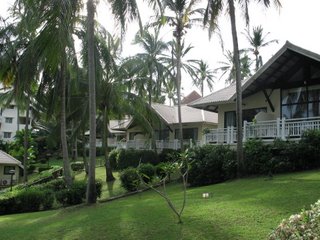But Phil Jarratt dispels this myth and many others in That Summer at Boomerang.
Written in the style of a non-fiction novel the book covers Kahanamoku's early life in a Hawaii where his tiny community of Waikiki "eked out a living from the sea or in small market gardens'' while a small number of planter barons built their mansions.
This was the end of the 19th century with the world of Hawaiian royalty fading and indignities endured as control of their islands was wrested from them.
The book covers his prowess as world record breaking and Olympic champion swimmer (he competed in three) and his life as a lifeguard, actor and finally long term Honolulu sheriff.
The bulk of the book, however, deals with his visit to Australia and New Zealand for three months in 1914.
It covers the well known legend of his association with the young Australian beach girl Isabel Letham and the moment when she rides the wave with Kahanamoku which is immortalized in standard surf histories as well as his exhausting swimming competition tour through both countries.
 |
| The Duke at Waikiki and Freshwater Beach |
Surfing was my choice of recreation for over 40 years so whenever I am in Honolulu I always wander down to the Duke's statue at Waikiki ( I know it's facing the wrong way) to pay my respects. When reading this book I was surprised to find out there is also a statue at Freshwater. And the USA government has issued a stamp in his memory which I have in safe keeping.
Whether you liked or loathed his politics, liked or loathed his movies, John Wayne stands out as a dominant Hollywood star of his era and is unquestioningly king of "the Western" genre with a career spanning 50 years and more than 175 movies.
John Wayne: The Life and Legend is lengthy biography well researched, detailed and basically non judgmental.
It traces the life of Marion Robert Morrison from his birth in 1907 in Winterset, Iowa (Bridges of Madison County country) through his nomadic childhood and 'apprenticeship' in minor roles to his stardom in Stagecoach and the dozens of other films that followed.
Apparently he altered his life's story, claiming to have become an actor almost by accident when really he had studied drama and wanted to act for most of his youth.
Many family members as well as friends and associates have offered previously unpublished reminiscences for this biography. In addition details from his production company's activities shed light on Wayne's business affairs.
And of course he married three times, all to Latina women, and conducted a lengthy affair with Marlene Dietrich.
The detailed analysis of Wayne's relationship with John Ford, the director with whom he's most associated and who made some of Wayne's greatest films is particularly interesting for the film buff.
A long book but never a tedious one.
Recommended!
As follow up to the above I came cross Company of Heroes by Harry Carey Jr., an actor who worked closely with both Wayne and Ford. His name might not ring a bell but the face is surely familiar.
Coming from an acting family, parents Harry and Olive Carey, he appeared in over ninety films and numerous TV series.
It is an interesting insider's look at Hollywood by someone who is not a big star but was privy to all that went on, off and on the screen.
Another one for the movie buff.
The Road from Coorain is an autobiography of the early life of Australian born Jill Ker Conway.
Brought up on an isolated 12900ha (32,000 acre) sheep station (ranch) in far western New South Wales with only two brothers for company, she became, by age seven, an important member of the workforce. She herded and tended the sheep, checked boundary fencing and lugged heavy farm supplies around. She was schooled entirely by her mother and a country governess.
Life was tough there especially during the seven years of drought. Following the accidental death of her father, her mother struggled on for another three years before the family moved to Sydney.
There Jill immersed herself in academia while dealing with an ever increasingly emotionally volatile mother and other family tragedies.
On graduation she found that the Australia of the late 1950s was not ready for women to take a leading role in business, academic or diplomatic positions so she set off for the United States where she achieved great success at institutions such as Harvard, MIT and Smith College and on boards of major commercial businesses.
She has received thirty-eight honorary degrees and awards from North American and Australian colleges, universities and women's organizations.
This is a fascinating book about life in rural and city Australia in the mid 20th century.
Unreservedly recommended.
The picture above is from Google and shows the type of country the beginning of this book is set in.
'Flat" is a word that comes to mind. We have driven over similar country when heading west from Sydney to Adelaide. You swear you can see the curvature of the earth especially on the Hay Plains.
It is also reminiscent of the prairie country of the western Dakotas.


























No comments:
Post a Comment